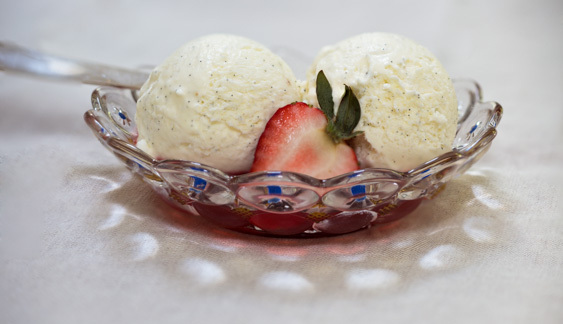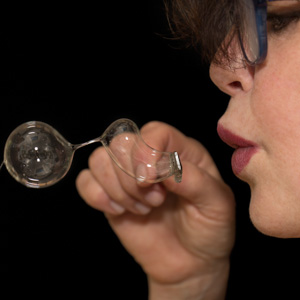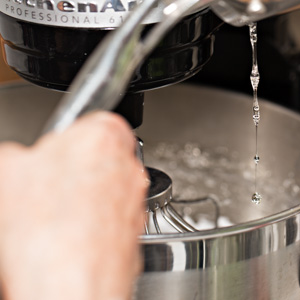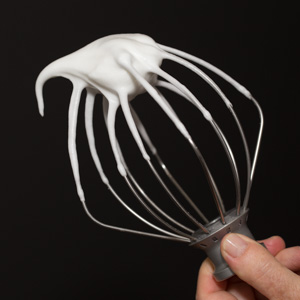Chantilly Meringue

introduction
I (Kay) first tasted this cream scooped from a shiny metal tray in a Florence gelateria. It pretended to be ice cream but bore none of the velvety palate-weight egg yolks bring to a frozen confection. It was, instead, implausibly light—a cold cloud-white cream with a vaguely glossy mouthfeel. I swooned. I realized this lovely contrivance must be borne of whipped cream and Italian meringue folded together and frozen. The experience remains a vivid once-in-a-lifetime memory for me, all the more chaste because I was traveling alone.
Forward to the present. For the profiterole recipe we developed, our desire for a cream as light as the puff it filled brought me back to the little cloud in a cup. Anything this elegant must exist within the classical battery of creams, mousses, and fillings. Where did we find it? In Julia Child’s Mastering the Art of French Cooking, volume 2! Et voilà!
Our take on this cream uses slightly different proportions than Julia’s more classic version, making it a trace less sweet. Julia calls the cream “chantilly meringue,” so we do, too. The Italians, presumably, call it something else. But the filling is a perfect hybrid of whipped cream and ice cream. It melts suavely on the tongue and slips easily down the throat. Sublime as a cream puff filling, it is delicious in a bowl with berries or sauce, as well.
My guests simply lifted their frozen cream–filled profiteroles and ate the ensembles like ice cream sandwiches, eschewing even sauce.
Cooking Remarks
The main thing to remember when making this confection is not to overbeat the cream, not to overbeat the egg whites, and not to overbeat the meringue. It is tempting to take each element too far, which will result in a Styrofoam-y final texture. The whipped cream should droop; the egg whites should look creamy but soupy when they’re prepared for the sugar syrup; and the beaten meringue, when ready for combining with the cream, should be supple and warm.
equipment mise en place
For this recipe, you will need a digital kitchen scale; a stand mixer with a whisk attachment and, ideally, an extra mixer bowl; a sharp paring knife; a heavy-bottomed small saucepan; a candy thermometer; a rubber spatula; and a 2-quart container for storage.
-
-
1plump vanilla bean, preferably Tahitian
-
16ounces (2 cups) cold heavy cream
-
4.25ounces (about ½ cup) egg whites
-
6ounces (¾ cup plus 2 tablespoons) sugar
-
2ounces (¼ cup) water
-
½teaspoon cream of tartar
-
-
Place the bowl of a stand mixer bowl and the whisk attachment in the freezer or refrigerator and let chill for at least 20 minutes.
-
Using a sharp paring knife, slice the vanilla bean in half lengthwise and scrape out the seeds. Pour the heavy cream into the chilled bowl, add the vanilla seeds, and whip on low speed until the whisk leaves a trail in the cream, about 40 seconds. Increase the speed slightly and continue to beat until the cream forms soft, droopy peaks when the whisk is lifted, about 20 seconds (fig. 2.1). Don’t overbeat the cream! If you have a second mixer bowl, place the bowl with the cream in the refrigerator; if you have only one mixer bowl, transfer the cream to another container, and place in refrigerator. Thoroughly wash and dry the second or now-empty mixer bowl, along with the whisk attachment.
-
Turn the egg whites into the clean stand-mixer bowl. Put all but 1½ tablespoons of the sugar into a heavy-bottomed small saucepan and pour in the water. Attach a candy thermometer to the side and place the pan over medium-high heat. As the liquid begins to bubble, swirl the pan to dissolve the sugar and as the syrup reaches a full simmer, swirl the pan intermittently (fig. 3.1). Reduce the heat to medium-low. Begin whipping the egg whites on medium speed; when they are foamy, add the cream of tartar and continue whipping. Check the sugar syrup’s progress; when it reaches 110 degrees, reduce the heat to low. When the egg whites have tiny bubbles and form very soft, loopy peaks—after 2 to 2½ minutes of whipping—stream the reserved 1½ tablespoons of sugar into the whites (fig. 3.2). While beating the whites, check the sugar syrup; the desired outcome is for the sugar syrup to reach 220 degrees at the same time the egg whites form glossy, soft peaks. Should one element appear to outpace the other, either lower the heat on the sugar syrup (or remove it from the burner altogether) or lower the speed on the mixer, and wait for the other to catch up. The progress of each should take no longer than 5 minutes. When the egg whites form soft peaks and the sugar syrup registers 220 degrees (alternatively, dip the looped handle of a measuring spoon into the syrup and blow; a continuous bubble should form, as in fig. 3.3), drizzle the hot syrup into the whites in a slow, steady stream (fig. 3.4) while continuing to whip on medium speed. After all the syrup has been added, increase the mixer speed to medium-high and whip the meringue until it has swelled to double its size and is almost cooled, about 2 minutes. Do not whip the meringue until it is stiff and dry; it should form droopy peaks when the whisk is lifted (fig. 3.5) and feel slightly warm to the touch.
-
Fold the cream into the meringue with a rubber spatula, taking care not to deflate either element but making sure the two are fully integrated. Turn the Chantilly meringue into a 2-quart container (fig. 4.1), lay plastic wrap directly against the surface, and freeze for at least 6 hours before serving (fig. 4.2). (The meringue will keep in the freezer for up to 2 weeks.)
-
-
2.1

-
-
-
3.1

-
3.2

-
3.3

-
3.4

-
3.5

-
-
-
4.1

-
4.2

-
Step photographs by Carol Dragon